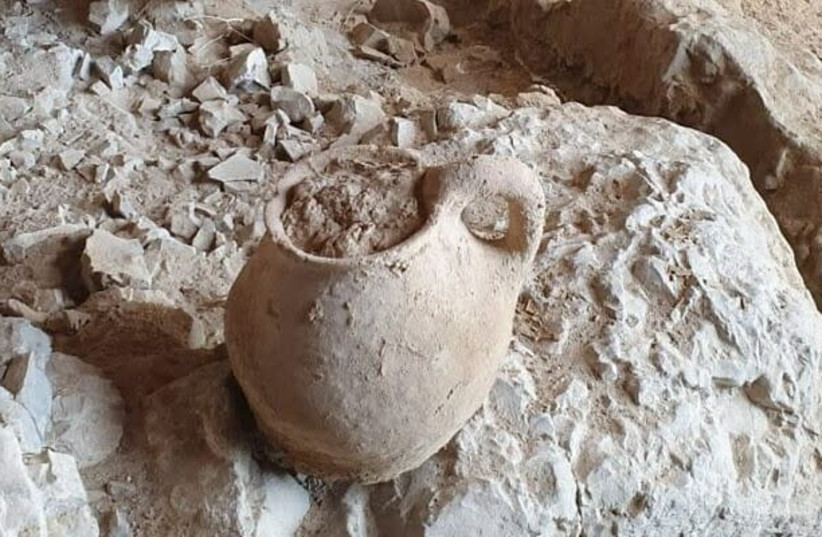The jug is believed to be 5,000 years old.
By ALL ISRAEL NEWS STAFF Published: MARCH 10, 2022 05:18
Ancient clay jug discovered in cave 53 of Qumran, Feb. 2022. (photo credit: Amir Ganor/Israel Antiquities Authority)
An American tourist accidentally discovered an ancient and well-preserved pottery vessel from the Early Bronze Age in Qumran, which is located in the Judean Desert close to the Dead Sea.
For more stories from ALL ISRAEL NEWS go to allisrael.com
Robbie Brown stumbled upon the ancient find in February as he and a friend decided to climb 328 feet to examine a cave known as Cave 53. The ancient jug is believed to be around 5,000 years old and could potentially be the first discovered complete jug unearthed in the area from this remote time-period.
Brown and his friend alerted Dr. Yuval Baruch from the Israel Antiquities Authority (IAA), the Israeli authority responsible for antiquities in Israel.
Amir Ganor, the director of the IAA’s robbery prevention unit, expressed his astonishment at Brown’s discovery.
“It’s amazing. Only about two years ago, our archaeologists surveyed the cave as part of a survey of the Judean Desert caves, which has been conducted continuously for the past five years and was intended to document and locate all ancient finds in the desert caves,” Ganor told Israeli media.
He emphasized the importance of the unearthed ancient artifact.
“In a few caves, pottery sherds were found, providing evidence of the Early Bronze Age. This is perhaps the first complete vessel we have found from this period in the caves in the Judean Desert,” Ganor said in an interview.
Brown is no stranger to archaeological discoveries in Israel. In 2017, he took part in an excavation in the same region, which resulted in the discovery of an ancient blank scroll, as well as ancient olive seeds and dates.
Ganor praised Brown for his professional handling of the discovery.
“It’s good that the person who entered the cave was Robbie, who participated in the excavation and is aware of the importance of the finds and their role in completing the archaeological puzzle of the Land of Israel,” Ganor said.
The head of IAA’s robbery prevention unit urged the public to contact the Israel Antiquities Authority in connection with discoveries of ancient artifacts: “We call on citizens who discover artifacts to leave them in place and call us immediately so that we can maximize the archaeological information from the find.”
Smuggling of valuable antiques is a growing problem in Israel and in other Middle Eastern nations. Many of the stolen artifacts are bought by wealthy private collectors in the West.
In a complex operation in February, Israeli authorities succeeded in confiscating thousands of stolen rare artifacts and arrested an Arab antiquities dealer in the city of Nablus in the West Bank. The massive trove, which was believed to be worth thousands of shekels, contained rare ancient coins used in the Land of Israel and artifacts from the Hellenistic and Persian eras.
Brig.-General Faris Atila, the Civil Administration head, stressed the importance of preserving archaeological finds in region.
“The Civil Administration is pursuing many avenues, both public and confidential, in order to preserve the archaeology of Judea and Samaria,” stated Atila.
“Following a long and intricate operation, thousands of rare archaeological items that had been stolen by a specialist in archaeological theft were located. The operation was important, with significance in breaking the chain of traffic in antiquities in Judea and Samaria. The Civil Administration will continue working tirelessly against the shameful phenomenon of destruction and theft at the archaeological sites of Judea and Samaria, protecting the cultural and historical assets of the area,” Atila said.
Qumran, in the Judean Desert, is an area full of caves and became world famous when, by chance, a Bedouin discovered the priceless Dead Sea Scrolls in 1947. Due to its remote location and dry air, the Judean Desert contains a high concentration of well-preserved ancient artifacts. Over the years, the Judean Desert region has attracted a large number of professional archaeologists and amateur archaeology buffs like Brown.
Archaeologists and historians believe that hundreds of Jews lived in the Qumran area in ancient times based on the number of discovered buildings and Jewish ritual baths.
This article was written by ALL ISRAEL NEWS and was first published here. It has been reprinted with permission.
Content retrieved from: https://www.jpost.com/christianworld/article-700842.
